There has been no greater strategy for effective classroom management than the classroom economy that engages and motivates my students all while teaching them responsibility and money management skills.
My room didn’t always used to be like this! I hopped from behavior management system to behavior management system trying to find something that would work. I was always looking for something new to grab the interest of my students and motivate them to do their best, but the lack of consistency caused more harm than good.
When I started the classroom economy in my classroom, I quickly realized it was what I was missing all along! It grabbed the interest of my students and motivated them to work hard. I was able to be consistent all year, but still offer variety that students want in things I offered in the store or ways that they could earn classroom cash. It met both criteria- easy to implement & maintain on my end AND kept the interest of my students all year!
I want to give you a FREE guide to start a classroom economy in your room! It has the printable money, students tracker page, a printable checkbook you can assemble for each student, coupons to get you started on your classroom reward store and a teacher tracker page to track fines.
Why Use a Classroom Economy?
Student Responsibility
Imagine a classroom floor where there are no pencils, erasers, or glue sticks rolling around. When you implement a classroom economy, students learn that they will be responsible for purchasing materials that get lost, damaged, or used-up. This means there may be some tears over a lost glue stick or asking to search their backpacks for the pencil they “know is in there”, but the amount of natural responsibility that develops when they have some skin in the game is astounding. They realize every decision has consequences, both good and bad. They are free to choose, but they are not free from the consequences of those choices.
Money Management Skills
A classroom economy allows students to develop money management skills first-hand in an environment where they are free to fail without any life-altering consequences. Here are just a few of the money management skills your students can leave with:
- Saving for Needs
Students will quickly realize that they need to have money set aside in their savings for things like glue sticks (we go through a lot of these with interactive notebooks), pencils, eraser caps, dry erase markers, etc.
- Saving for Wants
The classroom rewards store is full of all sorts of fun treasures. Students will learn to save for those wants instead of impulsively spending their whole paycheck on candy (they may have to learn the hard way!)
- Long-term saving
Students will save for long term expenses like rent at the end of the month and “retirement” at the end of the year.
- Paying “bills”
Students will have rent due each month, but they may also have weekly classroom fines to be paid.
- Taxes
Income tax can be introduced to students with their weekly paychecks.
- Generosity
Students learn the joy of giving generously from the money they worked hard to earn.
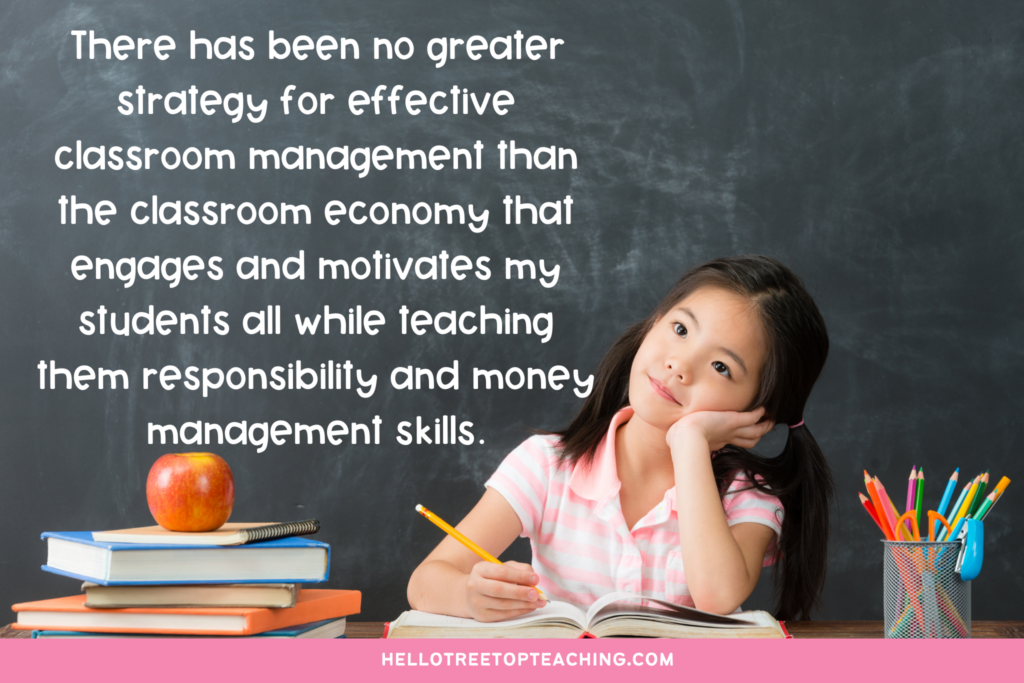
Supplies For a Classroom Economy
Some of the links on this site are affiliate links. This means that at zero cost to you, I will earn an affiliate commission if you click through the link and finalize the purchase.
Start by printing the fake classroom money (found in this free download) on different colored paper. I print the $1’s on green, the $5’s on pink, the $10’s on blue, the $20’s on yellow, and the $50’s on purple. I have found that it is incredibly helpful to have each different bill be a different color because it’s easier to differentiate. It also makes it easier when students are counting up their money at the end of the week to group their bills in piles of the same (hello skip counting practice).
I use a cash box to store the money for easy access while teaching, but you could really use anything. The goal is just to keep the money easily accessible by you, so you can easily use it to reward students on task.
Next you will need something for the students to keep their classroom money in as they earn throughout the week. I have students keep their money in these zipper pouches from Amazon which they keep in their desk. You could also use ziplock bags, pencil boxes or cases, or anything that will seal so that the money won’t fall out or be misplaced.
Classroom Store Supplies
You will also want to have some items available for purchase (more on setting that up later). I would say that 75% of my classroom reward store is school supplies and the other 25% is fun rewards that I know my students will like. Some examples of fun classroom store items are:
- Laptop/waterbottle sticker (this set from Amazon was what I ordered this year)
- Candy
- Small toys (bouncy balls, key chains, slime – Dollar Tree is awesome for this!)
- Larger ticket items (search the clearance sections at Walmart or Target)
- Desk pets and accessories (read about how I use them in upper elementary here!)
- Coupons (some printable options available for free in this download).
I also let my parents know a little about the classroom economy and ask them to send in donations. They know the sorts of things that are popular with their child, and often the items are a hit with the whole class. You will be amazed at the generosity of some parents!
Classroom Economy Set-Up
Ways to Earn Classroom Money
At the beginning of the year we come up with (together as a class) some ways that they will earn money. I do have some ideas in mind before this conversation, but it really helps build excitement for them to be part of the conversation. Some ways that I have them earn money are:
- Their class job (Set salaries for your jobs to be paid each week)
- Review games
- Set weekly assignments (could be completing homework, improving time on multiplication facts, answering a password question to get in the room in the morning, etc.)
- Following directions promptly the first time
- Kindness or consideration of others
- Random other times you want to hand out money – (whoever can spell all these words correctly, whoever can find all 4 nouns in this sentence, whoever can solve this tricky math problem, etc)
It is most effective to have some things that the students can rely on and expect each week and then also some things that keep them on their toes! When motivation or excitement is slipping, just tell a room full of students that there is $10 to the person who gets the most correct and watch the atmosphere of your classroom and determination of your students change before your eyes!
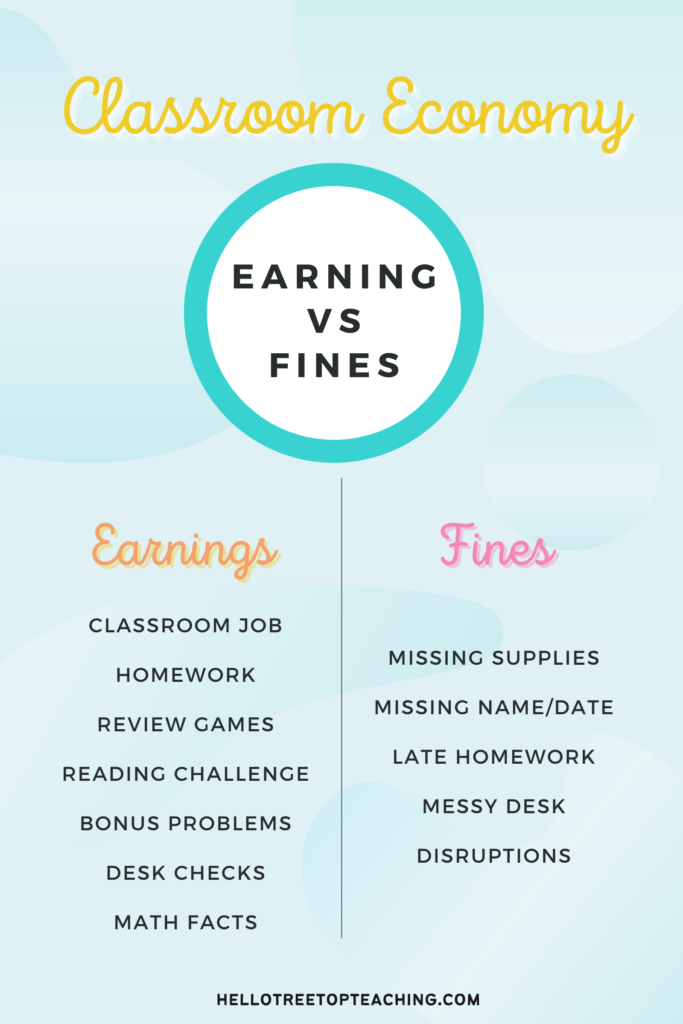
Classroom Economy Fines
You can take or leave the fines, but for me they have proven very effective. I will say that I don’t roll out fines until about week four of the classroom economy being under way. When I think they are ready, I have the students come up with things that they think should be a “fine”, and we write them in one big list. Here are some frequent examples:
- No name
- Late work
- Not following directions
- Messy desk/ book bin
- Disruptions
The best part is that you can add fines or take away fines as the dynamic of your class shifts. I had one class that just refused to capitalize words like names, I, and first words in a sentence and so I made every capital letter missing on graded written work a $0.25 fine. (I also spent two weeks teaching capital letters with this resource 😍).
Was it a lot to track? Yes!
Did it help them to be more conscious? Yes!
Did I track that all year long? No way!
I do use a tracker (part of this free download) where I have student names and the finable offences and I just keep tally marks. Sometimes I don’t even say anything when they get rowdy, I just stop teaching, walk to my clipboard, and start writing tallies. Talk about immediate silence 🙌🏼.
The amount of each fine will really depend on how much your students are earning per week. You can set amounts, and then go back and change them to be more or less depending on your class. Have the students get involved in these decisions- you may be surprised just how tough they are on themselves!
Ways to Spend Classroom Money
Student Pay Day
I pay the students each week on Friday. They have most likely been earning cash for little things throughout the week and should have placed that in their zipper pouch. Things like pay for their jobs, weekly homework logs, etc. are paid in classroom cash each Friday. I subtract their fines (just total from this free tracker page) from the amount they earned prior to giving them the money. I walk around doing this during morning work, seat work, group work, snack, or any other spare moment.
Purchasing Everyday Classroom Items
Now because the students are given so many opportunities to earn money, I also charge them for everything. 😂If a student needs a pencil, then that cost $10. If their glue stick runs out, that costs $10 to get a new one.
At first the kids are kind of upset by this, but I always give them these examples:
I took care of my washing machine, but after years of use, it still broke. I didn’t do anything wrong, but I had to replace it.
Even though I might take very good care of my car, it eventually is going to need new tires.
Having to use their money to purchase a supply that they need isn’t a consequence-it isn’t even a bad thing- it’s just life. And let me tell you… the students meticulously keep track of their materials. At the end of the day, there are no pencils, glue sticks, scissors or eraser caps on the floor because my students know that if they lose those things or run out of those things, they will have to purchase new ones.
Classroom Economy Store
This is always the students’ favorite part (and mine, too!). Even though they are paid weekly, I usually only do the store twice per month.
I have organized my classroom store into pencil boxes or baskets that are labeled by cost. This makes it easy to set up (just set out the boxes) and clean-up (close everything up and store it in the closet). Some larger ticket items have been individually priced by just writing with sharpie on the packaging.
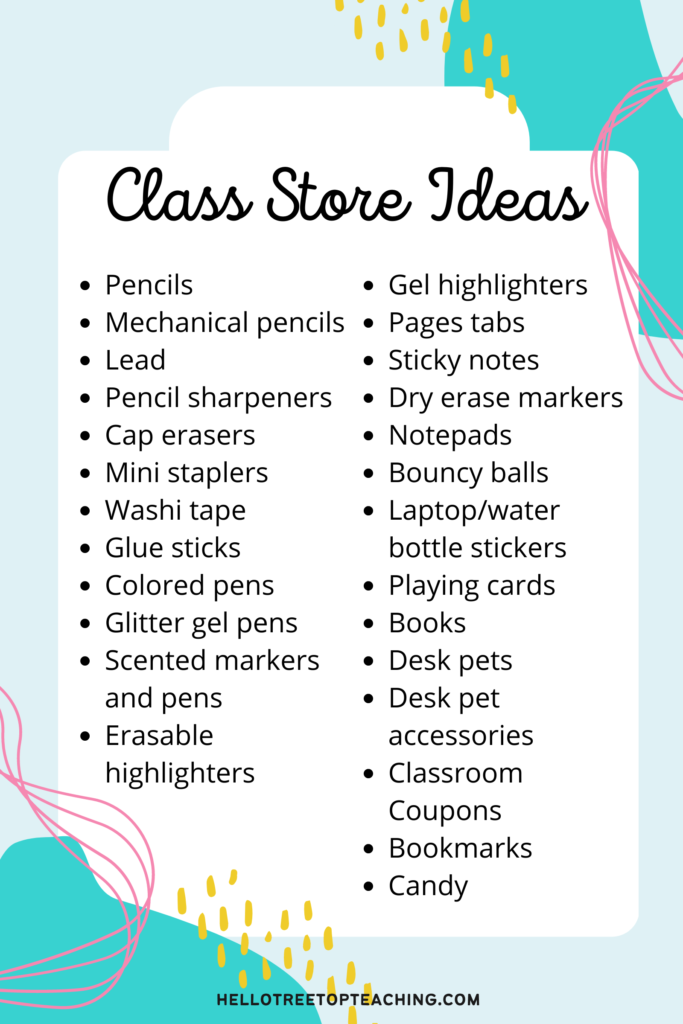
I do love to throw sales- especially on non-essential items! This gives them another opportunity to balance needs and wants.
When students are ready to check out, they will need to either have cash for their items or have enough in their savings account. You can deal with withdraws from the savings account in one of three ways:
- Teacher Tracks
This would be the teacher tracking the savings accounts from the Google Sheet. If the student has $20 in items to purchase but only $15 cash, the teacher would subtract $5 from the savings account.
- Student and Teacher Track
This would still be the teacher tracking on the Google sheet, but the students would track their own debits and credits from the account (using this free tracker page).
- Students and Teacher Track with Checkbook
Students would need to write a check (free checkbook in this download) for the amount they need to withdraw from their account and also track the withdraws on their tracker page, while the teacher would save the check and input all withdraws on the Google sheet.
Saving Accounts, Taxes, Retirement, and Rent
This system allows you to squeeze in so much money literacy, and the best part is that you can roll out these concepts just one at a time or not at all depending on your class.
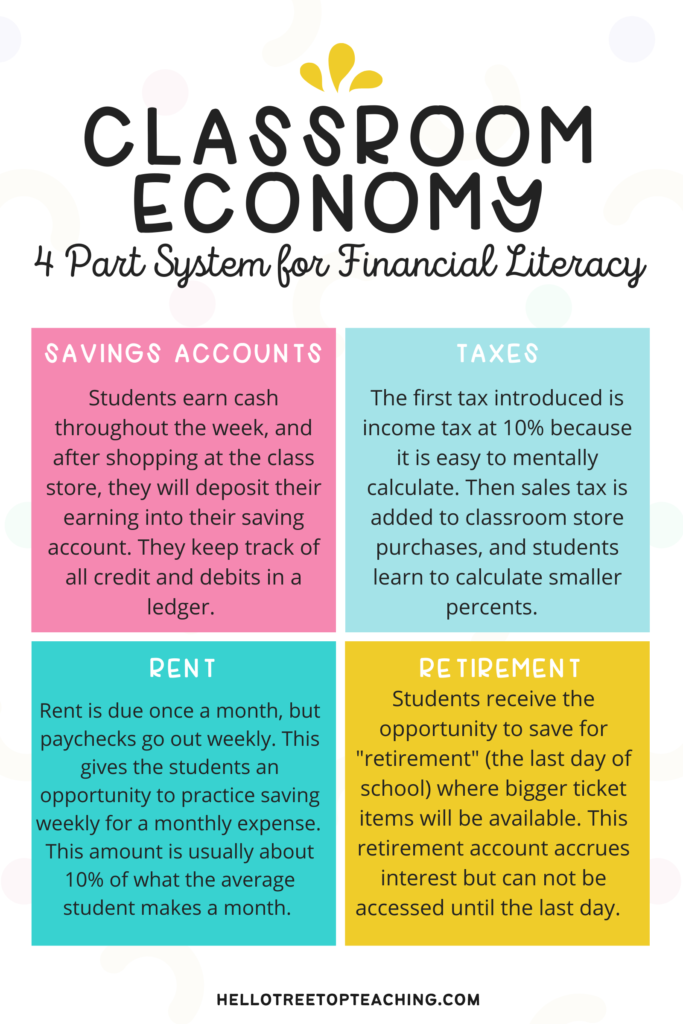
Classroom Savings Accounts
Savings accounts are the first thing to introduce mainly because you don’t want students holding on to $600 cash in their pencil box that explodes every time they open it. I may have learned this the hard way 😂.
Instead, I explain saving accounts. Yes, I explain because some kids have a hard time understanding how they can have money without actually having the tangible money. I use a very simple Google sheet that has the students’ names and their rolling account balance. I also give the students their own tracker page which they fold and store in their zipper pouch with their money. Anytime they add money to or take money from their savings account, they record it in their tracker.
I meet with each student after shopping at our class store twice a month, so they can deposit the money into their account. Hosting this one-on-one meeting is quick because students know they must already have their money counted and ready to go before coming to meet with me during seat work, snack time, morning work, or even small group math time!
Student Rent
When they have the hang of the savings account, I start to charge them rent for their desk and chair. Just be prepared for the kid who offers to give up his desk and chair so he doesn’t have to pay rent. 🤨
I like to have rent due once a month , but give them their paycheck for their job weekly. This way they have experience saving all month long for a bill due at the end of the month. You will have to price rent at something that is reasonable based on the average amount earned each week by the students in your class. I priced my rent at $30 per month thinking that the students should easily be able to save $7.50 per week.
Classroom Taxes
Taxes are where students are really shocked. I explain how items we buy are taxed at a certain percent (in most states) and how our income is taxed. Students are absolutely floored to find out that the income is taxed and then when you tell them usually it’s about 30%, they start falling out of chairs 😂.
But don’t panic! I don’t tax them at 30%. Depending on the class, I will either do 10% (great for mental math calculations) or something a bit trickier like 16% (great for multiplying by a decimal practice). And it can change as the year progresses.
I do not institute a tax on my store item simply for time sake- I don’t want to spend all day doing the classroom store. I just tell the students that tax is already built into the prices.
Retirement
This also gets a, “WHAT?!” from the students. But I remind them that one day, they will “retire” from 5th grade. In celebration of that day, there will be a collection of larger ticket items for purchase on the last week of school.
The benefit of the classroom retirement account, verse the classroom savings account, is that the retirement will grow at a rate of 3% with compound interest. (Insert math mini lesson about compound interest here!) The only thing- they CANNOT touch this account until that day when we cash out all accounts for retirement. This introduces another level of saving- long term saving!
Classroom Economy FAQs
What if a student runs out of classroom money?
Ahh, yes. 😑 Whether the student spent her entire paycheck on candy (and yes, I let them) or she simply just didn’t work as diligently to plan and save the money needed for rent, I don’t “punish” the student. However, a note is made on a sticky note on top of the cash box that that student owes money and will not receive any cash until the amount is paid off (I just keep track on the sticky note and throw it away when the balance is paid/earned).
If the student needs a new glue stick (happens all the time with interactive notebooks) and they don’t have it in their wallet or savings account, I will of course give them the glue stick, but follow the same procedures with the sticky note on the cash box to mark that the student is overdrawn.
This rarely happens twice. But if you wanted to really add a layer here, you could charge them interest until they pay it back.
What should I put in my classroom reward store?
You can visit my Amazon Storefront to see the entire collection of things I use in my class store.
Here are some items you can find in my classroom store for purchase:
- Pencils
- Mechanical pencils
- Lead
- Pencil sharpeners
- Cap erasers
- Mini staplers
- Washi tape
- Glue sticks
- Colored pens
- Glitter gel pens
- Scented markers and pens
- Erasable highlighters
- Gel highlighters
- Pages tabs
- Sticky notes
- Dry erase markers
- Notepads
- Bouncy balls
- Laptop/water bottle stickers
- Playing cards
- Books
- Desk pets
- Desk pet accessories
- Coupons for:
- Sitting at the teacher’s desk
- Extra recess
- Read outside
- Sit next to anyone for one day
- Wear slippers in the classroom
- Choose morning meeting activity
- Choose classroom job first
- Eat lunch with the teacher
- Class snack (provided by the teacher)
Get the Free Classroom Economy Starter Pack!
I want to give you this FREE guide to start a classroom economy in your room! It has the printable money, students tracker page, a printable checkbook you can assemble for each student, coupons to get you started on your classroom reward store, and a teacher tracker page to track fines.
Posts to Read Next:
How to Implement a Classroom Economy – This post by Kelly at the Simply Organized Teacher has lots of fun ideas for classroom incentives you can use with the classroom economy.
My Classroom Economy – This is an entire website dedicated to classroom economy ideas!
A Classroom Economy Students & Teachers Love – This post by Laura at Core Inspiration uses a pocket chart as a way to keep students money organized, and she talks a lot about implementing job applications.
Start Today!
A classroom economy will grab the interest of your students and motivate them to work hard. You will be able to maintain consistency all year, but still offer variety that students want in things you offer in the store or ways that they can earn classroom cash. It meets both criteria- easy to implement & maintain AND keeps the interest of your students all year!
There has been no greater strategy for effective classroom management than the classroom economy that engages and motivates my students all while teaching them responsibility and money management skills.
Some of the links below in this desk pets blog post are affiliate links. This means that, at zero cost to you, I will earn an affiliate commission if you click through the link and finalize a purchase

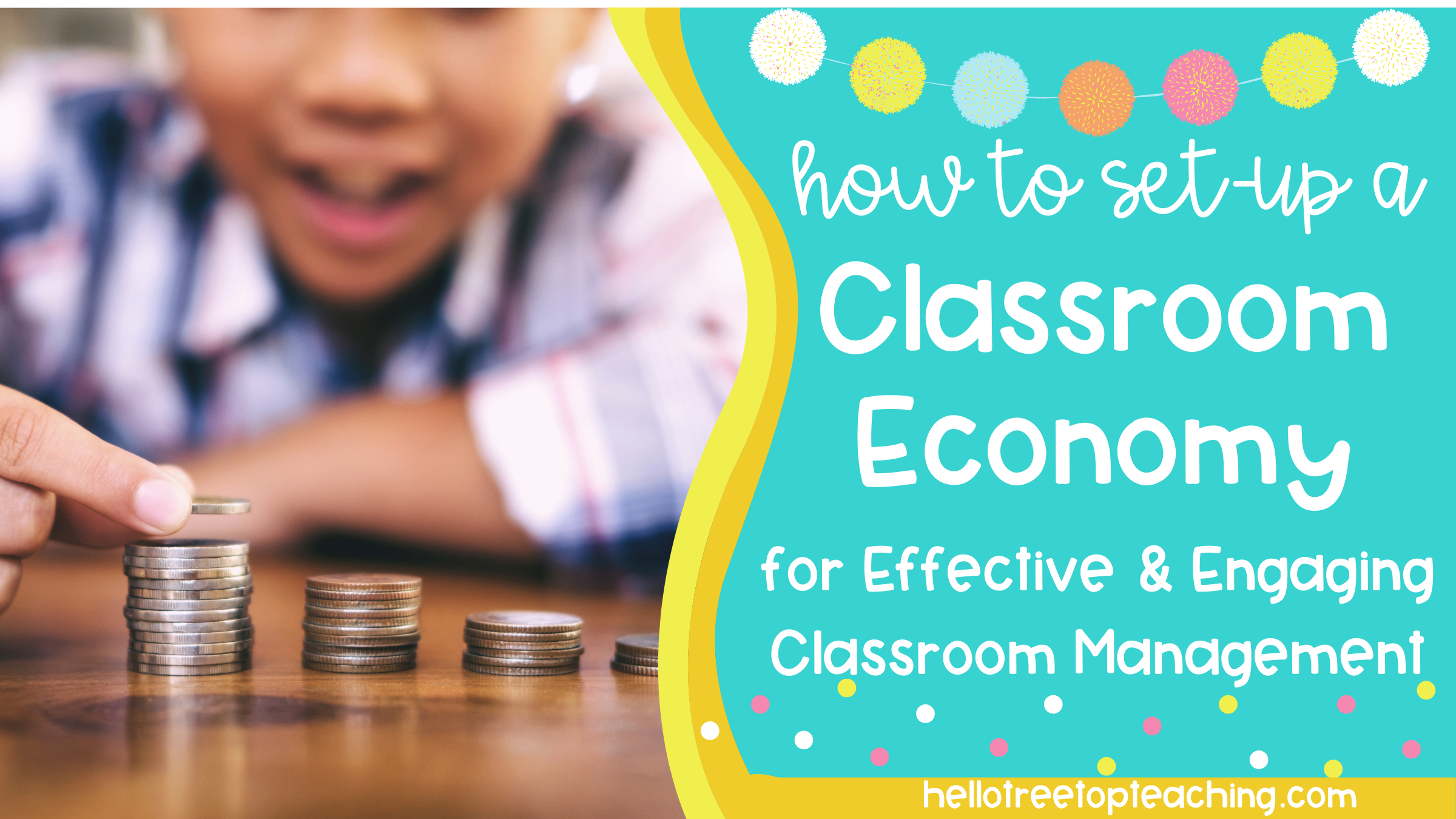

4 Responses
Can’t wait to try this!
I have a question on the classroom money system. How do you manage handing out and fining students when you have a substitute one day?
Great question! I don’t! When I have a sub, I can’t expect them to be able to grasp the full scope of the money in just a day or two. I tell students that a good report could be a “performance bonus” and negative report could result in fines.
I have implemented a similar economy system, modified for 3rd grade. Best part is the entrepreneurial spirit that develops. Eventually, there is always a student who offers to “ rent” out their glue stick or extra pencil to a classmate for a reduced cost. Additionally, when they are assigned a weekly job they don’t desire, they hire someone else to do it: if they are getting paid $5 for a task, they will pay a classmate $3 and bank the add ‘l 2 bucks. Overall, the system builds responsibility, ingenuity, and pride in the efforts!